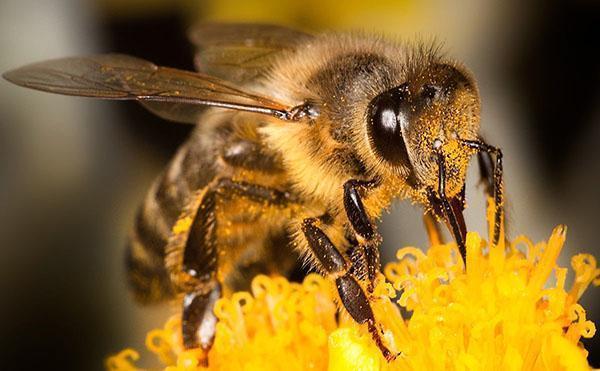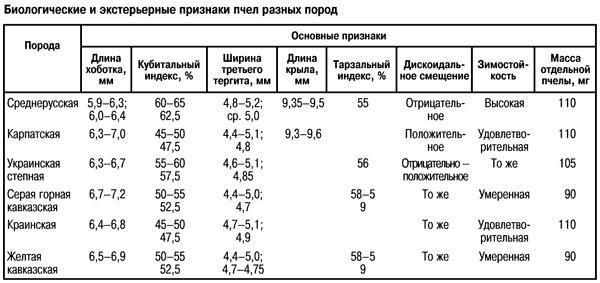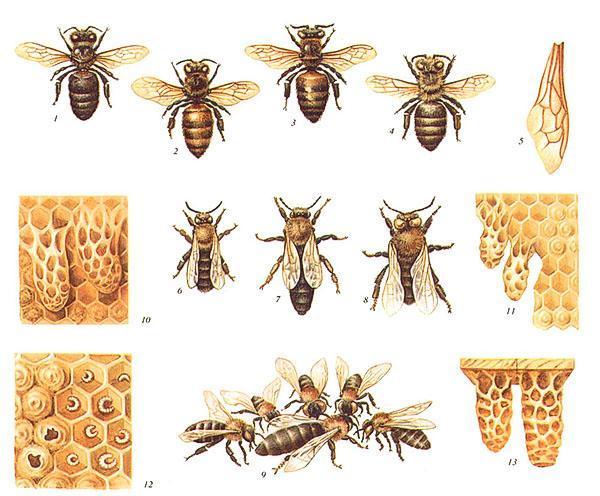Photos and descriptions of honey bees
 The bee breeds that exist in the world today appeared as a result of natural and artificial selection, started by people in the development of beekeeping and beekeeping.
The bee breeds that exist in the world today appeared as a result of natural and artificial selection, started by people in the development of beekeeping and beekeeping.
As a result, insects living in different parts of the world differ not only in many external signs, they have their own disposition, resistance to diseases and parasites, as well as the productivity of queens and, of course, honey-bearing ability.

In Russia, located in several climatic zones at once, several breeds of honeybees belonging to the Apis mellifera species have gained recognition.
 Species of bees: 1 — gray mountain Caucasian; 2 — yellow Caucasian; 3 — Italian; 4 - Carpathian
Species of bees: 1 — gray mountain Caucasian; 2 — yellow Caucasian; 3 — Italian; 4 - Carpathian
However, even with such a variety of choices, there are some nuances. In a meadow, where several dozen plants bloom at the same time, the Central Russian bee will lag far behind in terms of honey yield for Caucasian relatives.
But if next to the apiary there is, for example, a buckwheat field or planting of another melliferous crop, then here the Central Russian breed of bees will be out of competition due to the innate commitment to receiving a bribe from one plant until its flowering ends. Caucasian honey bees are less fastidious and work diligently wherever there is the slightest hint of nectar.
Descriptions and photos of bee breeds will help you get an idea of certain insects, their capabilities and features.
Dark European or Central Russian bee breed (Apis mellifera mellifera)
 The species of bees indigenous to Northern and Central Europe stands out in dark gray, without a hint of yellow color. This fact, as well as the prevalence in the territory of the central regions of Russia, determined the name of the bee breed.
The species of bees indigenous to Northern and Central Europe stands out in dark gray, without a hint of yellow color. This fact, as well as the prevalence in the territory of the central regions of Russia, determined the name of the bee breed.
These are fairly large insects that delight beekeepers with disease resistance and an excellent ability to survive the frosty long winters, being in the winter house for up to seven months a year. The queens of this breed can lay up to three thousand eggs per day, which ensures a rapid change of generations and the growth of families. Moreover, European, melliferous bees they are not inclined to form swarms and are rather peaceful. However, they are noticeably nervous if the beekeeper shows negligence to them or allows too rough, sharp intervention in the affairs of the hive.
 The special adherence of insects to collecting only from one honey plant on the one hand makes it possible to obtain delicious monocultural honey, for example, from acacias, buckwheat, linden trees and other plants, but on the other hand, leads to a delay in the transition of bees from already practically faded crops to new, better honey plants.
The special adherence of insects to collecting only from one honey plant on the one hand makes it possible to obtain delicious monocultural honey, for example, from acacias, buckwheat, linden trees and other plants, but on the other hand, leads to a delay in the transition of bees from already practically faded crops to new, better honey plants.
The Central Russian breed of bees starts storing honey from the upper part of the hull or stores, and only then stocks appear in the brood area.
Gray mountain Caucasian breed of bees (Apis mellifera caucasica)
 The gray Caucasian mountain bee differs from the Central Russian bee breed in its ability to quickly switch from one honey plant to another, in its large size, but less winter hardiness. This population mainly lives in the southern regions of the country, and is especially popular in the apiaries of the North Caucasus and foothill areas.
The gray Caucasian mountain bee differs from the Central Russian bee breed in its ability to quickly switch from one honey plant to another, in its large size, but less winter hardiness. This population mainly lives in the southern regions of the country, and is especially popular in the apiaries of the North Caucasus and foothill areas.
The queen of the gray mountain bee can lay up to one and a half thousand eggs in the day. Moreover, in the days of the most intensive collection of honey, even bees fly out of the hive for a bribe, at other times they take care of the future generation. The gray Caucasian bees are the record-holders among the honeybees in terms of the tongue length, reaching 7.2 mm.
This breed of bees is characterized by early departure from the hive and very late evening return. Insects are not afraid of fog and drizzling rain, even in such a weather that is not the most suitable for bees, they continue to collect, and they do not mind to profit from the gaping fellows.
Priokskaya variety of the Central Russian bee breed
On the basis of the Caucasian gray insects and the Central Russian breed of bees, an intermediate variety was bred, called the Prioksky. These honey bees have a smaller proboscis length than the Caucasians, they are better adapted to the frosty Russian winters, are more resistant to diseases and a little more aggressive. Outwardly, this type of bee is more like its mountain ancestors. In insects, the predominant gray color, yellow markings are found only occasionally, on the upper segments of the abdomen.
Krajinskaya breed of bees (Apis mellifera carnica)
 Bees from Carinthia and Carinthia gained European fame more than a hundred years ago. A characteristic feature of these insects has become not only an amazing peacefulness, but also the ability to quickly and efficiently collect honey in the conditions of a fleeting alpine spring, when bribes are not pleasing in abundance. Moreover, according to the photos and descriptions, this breed of bees is distinguished by good winter hardiness and endurance on hot summer days. Keeping small families of the Krajina bee in winter is very economical.
Bees from Carinthia and Carinthia gained European fame more than a hundred years ago. A characteristic feature of these insects has become not only an amazing peacefulness, but also the ability to quickly and efficiently collect honey in the conditions of a fleeting alpine spring, when bribes are not pleasing in abundance. Moreover, according to the photos and descriptions, this breed of bees is distinguished by good winter hardiness and endurance on hot summer days. Keeping small families of the Krajina bee in winter is very economical.
Today, the krainsky breed of bees, or karnik, is one of the most popular species in Europe. The body of the insect is distinguished by a gray-silver color. Bees fly out of the hive early, which makes it possible to receive bribes from the very first spring honey plants. According to statistics, only a third of families can swarm, and if they start the appropriate work on time, it is easy for them to return to their working spirit. In agriculture, the bee breed is prized as a pollinator for red clover. The proboscis reaches a length of 6.8 mm.
 The queen bee lays from 1.5 to 2 thousand eggs per day.
The queen bee lays from 1.5 to 2 thousand eggs per day.
That is, the carnica, as a breed of bees, combines the best qualities of gray Caucasian and Carpathian insects. First of all, during mass honey collection, bees fill the combs with brood, and then move to the store frames.
Carpathian bee (Apis mellifera carpatica)
Another breed of European honey bees is called Carpathian by its place of origin and habitat. The predominant color in the coloration of the Carpathian bee is gray. The insect is distinguished by a long, up to 7 mm proboscis, good winter hardiness, peaceful character and low sugar content in honey. The queens of this type of bees lay up to 1800 eggs per day.
 The features of the breed include the early readiness of worker bees to collect honey. However, with a lot of positive quality, Carpathian bees also have a number of disadvantages. These include the tendency to embezzle someone else's bribe, if there is a shortage of flowering melliferous plants in the district, as well as the absence of any resistance to the wax moth penetrating into the hive.
The features of the breed include the early readiness of worker bees to collect honey. However, with a lot of positive quality, Carpathian bees also have a number of disadvantages. These include the tendency to embezzle someone else's bribe, if there is a shortage of flowering melliferous plants in the district, as well as the absence of any resistance to the wax moth penetrating into the hive.
Italian breed of honey bees (Apis mellifera liqustica)
 The breed of bees from the south of Europe, in comparison with other relatives, has a more golden color, the highest fecundity of queens, up to 3500 eggs per day, excellent disease resistance and a low probability of swarming.
The breed of bees from the south of Europe, in comparison with other relatives, has a more golden color, the highest fecundity of queens, up to 3500 eggs per day, excellent disease resistance and a low probability of swarming.
The southern origin of this breed of bees determined not too high frost resistance of insects. But the bees of the Italian variety quickly switch from honey plant to honey plant, looking for the most profitable bribes, and are also extremely clean.
 The huge number of eggs laid by the uterus predetermined one feature that must be taken into account when working with insects. The brood is of paramount importance for this breed, and with a small amount of honey collection, bees can give all the bribes to the younger generation.
The huge number of eggs laid by the uterus predetermined one feature that must be taken into account when working with insects. The brood is of paramount importance for this breed, and with a small amount of honey collection, bees can give all the bribes to the younger generation.
Asian honey bees
European insects, belonging to the Apis mellifera species, are not widely distributed in Asia. Here for many millennia has developed its own population of bees and the tradition of beekeeping and beekeeping.
 Today, experts count up to nine species of bees, indigenous to the Asian part of the world. Among them, the most famous and interesting are: Apis dorsata, Apis cerana, Apis floreа.
Today, experts count up to nine species of bees, indigenous to the Asian part of the world. Among them, the most famous and interesting are: Apis dorsata, Apis cerana, Apis floreа.
 A prominent representative of the bee family is the Himalayan mountain giant bee Apis dorsata laboriosa with a dark belly decorated with thin white stripes. This breed lives on steep rocks, where it builds huge combs by European standards up to 160 cm long and about 80 cm wide.
A prominent representative of the bee family is the Himalayan mountain giant bee Apis dorsata laboriosa with a dark belly decorated with thin white stripes. This breed lives on steep rocks, where it builds huge combs by European standards up to 160 cm long and about 80 cm wide.
 The work of a bee keeper in such conditions becomes akin to the work of an extreme climber, who risks not only falling from a great height, but also being attacked by a mass of not the most friendly Himalayan bees.
The work of a bee keeper in such conditions becomes akin to the work of an extreme climber, who risks not only falling from a great height, but also being attacked by a mass of not the most friendly Himalayan bees.
The dwarf Asian bee or Apis florea dwarf makes honeycombs in trees or bushes. The modest size of insects, first described in the 18th century, allows us to say that these bees are one of the smallest not only in Asia, but throughout the entire planet. For a year, the family of these honeybees can collect no more than a kilogram of honey, but at the same time they staunchly protect their nests and are valued in agriculture as pollinating insects.
The Chinese wax bee or Apis cerana can be considered an equal rival of the European honey bee. This type of Indian or Himalayan bee is widespread in most regions of Asia. These insects are also found in the Russian Far East. For example, in the Primorsky Territory, this breed of honey bees included in the Red Book can rarely be seen in the forest zone.